

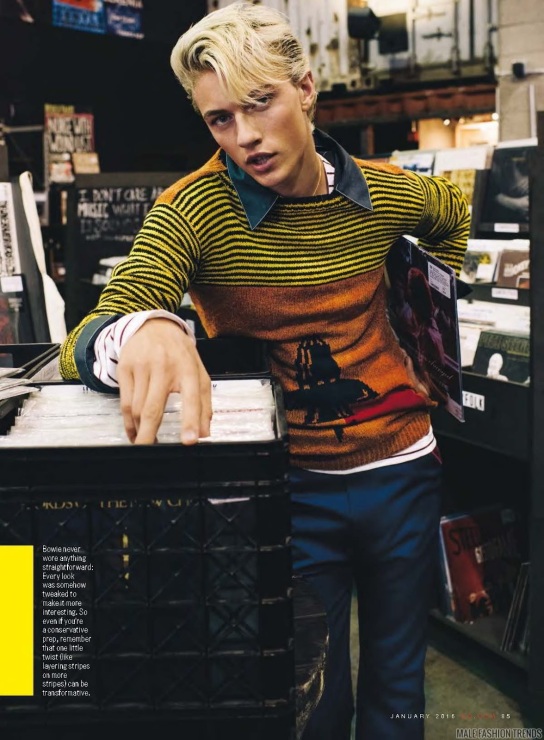



Model: Lucky Blue Smith
Photographer: Sebastian Kim
GQ, January 2016







Model: Lucky Blue Smith
Photographer: Sebastian Kim
GQ, January 2016
“He made the shoes larger than life and gave them a personality,” said Donna De Salvo, chief curator at the Whitney Museum of American Art in New York City. “He makes them into portraits without a face and turns them into objects of desire. He understood how images drive the world.”
Donna De Salvo
(about Andy Warhol’s obsession for shoes)
Heels, flats, boots. Whatever. And like his later obsessions with soup cans, Brillo boxes and Marilyn Monroe, his footwear fetish became the stuff of art.
During the 1950s, Warhol gained fame for his whimsical ink drawings of shoe advertisements. These were done in a loose, blotted-ink style, and figured in some of his earliest showings at the Bodley Gallery in New York. With the concurrent rapid expansion of the record industry and the introduction of the vinyl record, Hi-Fi, and stereophonic recordings, RCA Records hired Warhol, along with another freelance artist, Sid Maurer, to design album covers and promotional materials.
Warhol was an early adopter of the silk screen printmaking process as a technique for making paintings. His earliest silk screening in painting involved hand-drawn images though this soon progressed to the use of photographically derived silk screening in paintings. Prior to entering the field of fine art, Warhol’s commercial art background also involved innovative techniques for image making that were somewhat related to printmaking techniques. When rendering commercial objects for advertising Warhol devised a technique that resulted in a characteristic image. His imagery used in advertising was often executed by means of applying ink to paper and then blotting the ink while still wet. This was akin to a printmaking process on the most rudimentary scale.



By the beginning of the 1960s, Warhol had become a very successful commercial illustrator. His detailed and elegant drawings for I. Miller shoes were particularly popular. They consisted mainly of “blotted ink” drawings (or monoprints), a technique which he applied in much of his early art. Although many artists of this period worked in commercial art, most did so discreetly. Warhol was so successful, however, that his profile as an illustrator seemed to undermine his efforts to be taken seriously as an artist.
Since he considered him a great inspiration for his works, David Bowie introduced a B-side on his album Honky Dory (1971) called Andy Warhol.
In his 2003 interview with Performing Songwriter magazine, Bowie explained that he had not met Warhol when he wrote this song and he got an interesting reaction when he played it for him. Said Bowie: “I took the song to The Factory when I first came to America and played it to him, and he hated it. Loathed it. He went [imitates Warhol’s blasé manner] ‘Oh, uh-huh, okay…’ then just walked away (laughs). I was left there. Somebody came over and said, ‘Gee, Andy hated it.’ I said, ‘Sorry, it was meant to be a compliment.’ ‘Yeah, but you said things about him looking weird. Don’t you know that Andy has such a thing about how he looks? He’s got a skin disease and he really thinks that people kind of see that.’ I was like, ‘Oh, no.’ It didn’t go down very well, but I got to know him after that. It was my shoes that got him. That’s where we found something to talk about. They were these little yellow things with a strap across them, like girls’ shoes. He absolutely adored them. Then I found out that he used to do a lot of shoe designing when he was younger. He had a bit of a shoe fetishism. That kind of broke the ice. He was an odd guy.
A renegade who created alter egos to complement his music, Bowie never stopped experimenting with avant-garde clothes and footwear. Where others were measured or manufactured, he was a fearless original who shot from his slim androgynous hip, using a special shoe or statement ensemble as an extension of his indelible art. His early ’70s incarnation, Ziggy Stardust, had a love of star-spangled and glittery boots. Bowie had said he took cues from sci-fi novels and Japanese theater. Everyone from Tommy Hilfiger to Marc Jacobs and Jean Paul Gaultier has shown their version of Ziggy. On the red carpet and off, Cara Delevingne and Chiara Ferragni have worn looks in this vein.
In 1976, Bowie unveiled The Thin White Duke, which inspired a whole generation to embrace a more sleekly suited and booted sensibility with a futuristic twist. Runways from Celine to Chanel and Balmain have shown collections that riffed on this theme. And Carine Roitfeld often dresses in a style not unlike this. The footwear was often all-white, block-heeled or platformed. Laurence Dacade did a pair of boots in an apparent homage for spring ’16.

From the series: Diamond Dust Shoes (1981)
Warhol ought to have solarized Bowie using one of his patent silk screening techniques, but Bowie was already a solarized image, a diffraction of light infusing every pore of artistic life of his time. Bowie was a shoe aficionado and when he met Warhol they found a common ground. A ground made of stardust on which to walk and leave the foot-marks of their art.
 Hannelore Knuts as David Bowie in fashion editorial Rock the House, photographed by Steven Meisel. US Vogue, 2001
Hannelore Knuts as David Bowie in fashion editorial Rock the House, photographed by Steven Meisel. US Vogue, 2001
 Kate Moss portraying Bowie’s Aladdin Sane for Vogue UK. May 2003. Photo by Nick Knight
Kate Moss portraying Bowie’s Aladdin Sane for Vogue UK. May 2003. Photo by Nick Knight
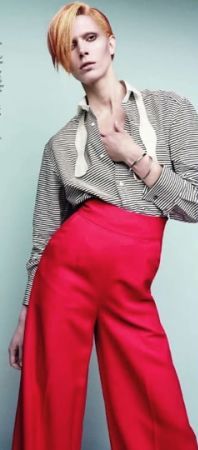
 Raquel Zimmermann in Girl Meets Boy by David Sims, June 2010
Raquel Zimmermann in Girl Meets Boy by David Sims, June 2010
 Editorial: Androgyne
Editorial: Androgyne
Magazine: Vogue Paris October 2010
Model: Iselin Steiro
Photographer: David Sims
Stylist: Emmanuelle Alt
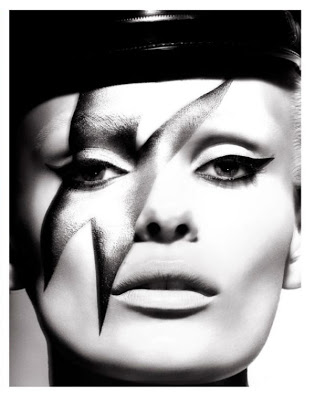

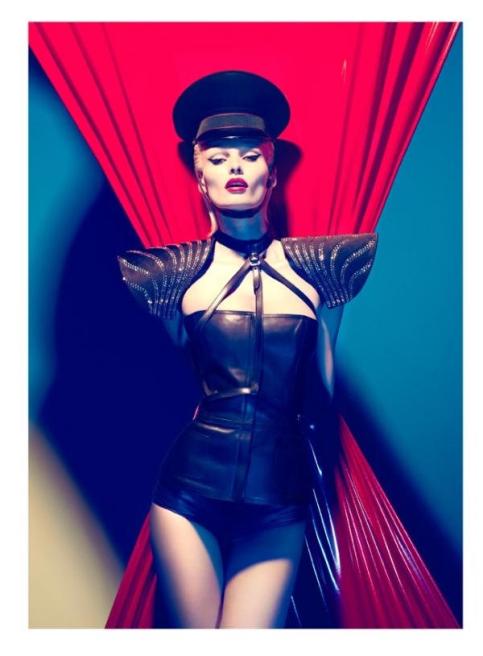 Edita Vilkeviciute in Numéro #123rd issue, May 2011
Edita Vilkeviciute in Numéro #123rd issue, May 2011
 Kate Moss portraying Ziggy Stardust for Vogue Paris. December 2011/January 2012. Photo by Alas & Piggott
Kate Moss portraying Ziggy Stardust for Vogue Paris. December 2011/January 2012. Photo by Alas & Piggott


 Daphne Guinness. Photo by Brian Adams for German Vogue, January 2013 issue
Daphne Guinness. Photo by Brian Adams for German Vogue, January 2013 issue
Photos by Masayoshi Sukita
Bowie and Yamamoto
Jean-Paul Gaultier Spring/Summer 2013 Ready-to-wear collection
Kansai Yamamoto (山本 寛斎), born on February 8, 1944 in Yokohama, Japan, is one of the leaders in Japanese Contemporary fashion, in particular during the 1970s and 1980s.
After studying civil engineering and English at Nippon University ,got a so-en prise at Bunka Fashion College in 1967 .
Among the designers with whom he apprenticed are Junko Koshino and Hisashi Hosono; in 1971, he opened his own company, Yamamoto Kansai Company, Ltd., Tokyo. His first collection debuted in London in 1971 and in the USA at Hess’s Department Store in Allentown, Pennsylvania, which was renowned for many avant-garde collections. His 1975 debut in Paris was followed by the opening of his Kansai Boutique in 1977.
In 1999, he and Junko Koshino renewed the kimono, reviving interest in this classical fashion. He is also known for his avant-garde kimono designs, including ones worn by David Bowie in his Ziggy Stardust Tour.
In 2008, an exhibit named Netsuki Shinten: Kansai Genki Shugi (or Passionate Exhibit: The Energy Principle of Kansai) was held at the Edo-Tokyo Museum. In 2009, a major retrospective of Yamamoto’s work was exhibited at the Philadelphia Museum of Art.
Yamamoto designed the Skyliner train, unveiled in 2010, that connects Japan’s Narita Airport with central Tokyo.
In July 2013, he made a comeback to the fashion industry with a showing in the 19th New Britain Mask Festival in Kokopo, Papua New Guinea.
Station to Station is the tenth studio album by English musician David Bowie. Commonly regarded as one of his most significant works, Station to Station was the vehicle for his last great “character”, the Thin White Duke. The album was recorded after he completed shooting Nicolas Roeg‘s The Man Who Fell to Earth, and the cover artwork featured a still from the movie.
It was on the set of his first major film, The Man Who Fell to Earth, that Bowie began writing a pseudo-autobiography called The Return of the Thin White Duke. He was also composing music on the understanding that he was to provide the picture’s soundtrack, though this would not come to fruition. (At Bowie’s recommendation, John Phillips of the Mamas and the Papas would write and produce all the original music for the film instead.) Director Nicolas Roeg warned the star that the part of Thomas Jerome Newton would likely remain with him for some time after production completed. With Roeg’s agreement, Bowie developed his own look for the film, and this carried through to his public image and onto two album covers over the next twelve months, as did Newton’s air of fragility and aloofness.
The Thin White Duke became the mouthpiece for Station to Station and, as often as not during the next six months, for Bowie himself. Impeccably dressed in white shirt, black trousers and waistcoat, the Duke was a hollow man who sang songs of romance with an agonised intensity, yet felt nothing—”ice masquerading as fire”. The persona has been described as “a mad aristocrat”, “an amoral zombie”, and “an emotionless Aryan superman”. For Bowie himself, the Duke was “a nasty character indeed”.
Low is the eleventh studio album by British musician David Bowie, co-produced by Bowie and Tony Visconti. Widely regarded as one of Bowie’s most influential releases, Low was the first of the “Berlin Trilogy”, a series of collaborations with Brian Eno (though the album was mainly recorded in France and only mixed in West Berlin). The experimental, avant-garde style would be further explored on Heroes and Lodger. The album’s working title was New Music Night and Day.
The genesis of Low lies in both the foundations laid by Bowie’s previous album Station to Station, and music he intended for the soundtrack to The Man Who Fell to Earth. When Bowie presented his material for the film to Nicolas Roeg, the director decided that it would not be suitable. Roeg preferred a more folksy sound, although John Phillips described Bowie’s contributions as “haunting and beautiful”. Elements from these pieces were incorporated into Low instead. The album’s cover, like Station to Station, is a still from the movie: the photographic image, under the album’s title, formed a deliberate pun on the phrase “low profile”.
Although the music was influenced by German bands such as Kraftwerk and Neu!, Low has been acclaimed for its originality and is considered ahead of its time, not least for its cavernous treated drum sound created by producer Visconti using an Eventide Harmonizer.
Study for the Montée, František Kupka
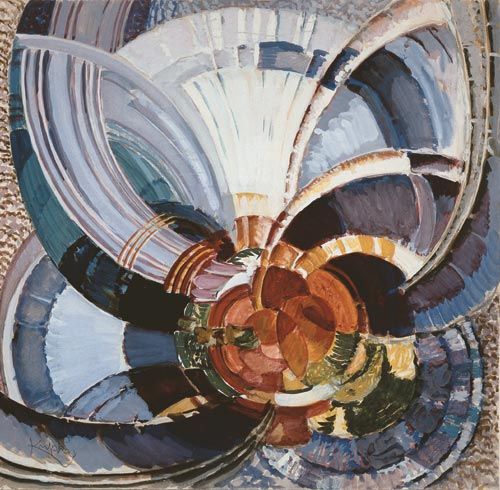 Study for Around a Point, František Kupka
Study for Around a Point, František Kupka
 Circular Forms, Robert Delaunay
Circular Forms, Robert Delaunay
Orphism or Orphic Cubism, a term coined by the French poet Guillaume Apollinaire at the Salon de la Section d’Or in 1912, referring to the works of František Kupka. During his lecture at the Section d’Or exhibit Apollinaire presented three of Kupka’s abstract works as perfect examples of pure painting, as anti-figurative as music.
This movement, perceived as key in the transition from Cubism to Abstract art, was pioneered by František Kupka, Robert Delaunay and Sonia Delaunay, who relaunched the use of color during the monochromatic phase of Cubism.The meaning of the term Orphism was elusive when it first appeared and remains to some extent vague.
The Symbolists had used the word orphique in relation to the Greek myth of Orpheus, who they perceived as the ideal artist. Apollinaire had written a collection of quatrains in 1907 entitled Bestiaire ou cortège d’Orphée (Paris, 1911), within which Orpheus was symbolized as a poet and artist. For both Apollinaire and the Symbolists who preceded him, Orpheus was associated with mysticism, something that would inspire artistic endeavors. The voice of light that Apollinaire mentioned in his poems was a metaphor for inner experiences. Though not fully articulated in his poems, the voice of light is identified as a line that could be colored and become a painting. The Orphic metaphor thus represented the artist’s power to create new structures and color harmonies, in an innovative creative process that combined to form a sensuous experience.
Even after 1913, when Apollinaire had separated from the Delaunays and Orphism had lost its novelty as a new art form, the Delaunays continued painting in their personal shared style. They may not have always called their work Orphic, but the aesthetics and theories were the same. Robert continued painting while Sonia delved into other media, including fashion, interior and textile design, all within the realm of Orphism.
 Norman Rockwell preparing to enter a mosque
Norman Rockwell preparing to enter a mosque
 Omar Sharif in Lawrence of Arabia (David Lean, 1962). Sharif’s first English-language role was that of Sharif Ali in David Lean’s historical epic. This performance earned him a Best Supporting Actor Oscar nomination and a Golden Globe Award for Best Supporting Actor – Motion Picture, as well as a shared Golden Globe Award for New Star of the Year – Actor.
Omar Sharif in Lawrence of Arabia (David Lean, 1962). Sharif’s first English-language role was that of Sharif Ali in David Lean’s historical epic. This performance earned him a Best Supporting Actor Oscar nomination and a Golden Globe Award for Best Supporting Actor – Motion Picture, as well as a shared Golden Globe Award for New Star of the Year – Actor.
 Irish actor Peter O’Toole studying for his role as T.E. Lawrence. Photo by Dennis Oulds
Irish actor Peter O’Toole studying for his role as T.E. Lawrence. Photo by Dennis Oulds
 Lawrence of Arabia (David Lean, 1962)
Lawrence of Arabia (David Lean, 1962)
 Robert Pattinson as Lawrence of Arabia in Queen of the Desert (Werner Herzog, 2015), based on the life of British traveller, writer, archaeologist, explorer, cartographer and political officer Gertrude Bell.
Robert Pattinson as Lawrence of Arabia in Queen of the Desert (Werner Herzog, 2015), based on the life of British traveller, writer, archaeologist, explorer, cartographer and political officer Gertrude Bell.
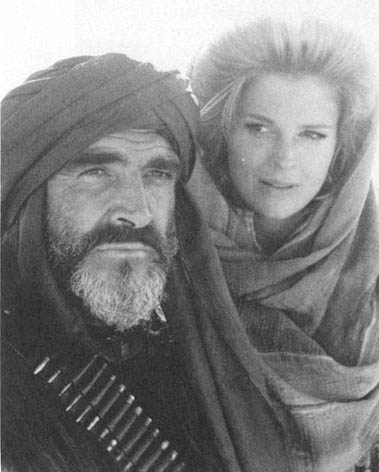
 Candice Bergen and Sean Connery in The Wind and the Lion (John Milius, 1975)
Candice Bergen and Sean Connery in The Wind and the Lion (John Milius, 1975)
 Virginia Woolf (far left) and her friends, dressed as Abyssinian dignataries, 1910
Virginia Woolf (far left) and her friends, dressed as Abyssinian dignataries, 1910
 Truman Capote in Tangier (Morocco)
Truman Capote in Tangier (Morocco)
 Yves Saint Laurent in Marrakesh
Yves Saint Laurent in Marrakesh

 Christian Louboutin purchased a villa near the Nile river
Christian Louboutin purchased a villa near the Nile river
‘The overwhelming sensuality of the natural world, whose life force is one of pure desire”
Marc Quinn
 Etymology of Desire, Marc Quinn, 2010. Quinn began his first series of orchids in 2008
Etymology of Desire, Marc Quinn, 2010. Quinn began his first series of orchids in 2008
Alexander McQueen by Sarah Burton, Spring/Summer 2015 collection
Etymology Of Desire and Prehistory Of Desire (2010) were the centerpiece of the Alexander McQueen women’s ready-to-wear Spring/Summer 2015 show in Paris Fashion Week. Cast from real flowers and parading, the orchids meditate on the human obsession of ideal beauty, achieved through the manipulation, modification and control of nature.
They were gargantuan, even dwarfing the typically attenuated McQueen models, hiked up on platform boots with a curving calligraphic heel. And they got the point across concisely – exotic, oriental, feminine. All pointers Sarah Burton wanted you to pick up in the clothes.
Maybe Burton was juxtaposing her fashion with art to assert the difference between the two. McQueen is one label that’s often lumped into that “art” category, and her last collection provoked criticism from some quarters for a degree of preciousness that pushed it beyond the realm of ready-to-wear.




 The Diary of a Dress: Alexander McQueen Shares the Saga of How One of His Inspirations – A Peter Arnold’s Orchid Photograph – Evolved from Simple Sketch to Production Nightmare to a Stunning Gown Fit for Supermodel Naomi Campbell. Writer: Lisa Armstrong, Harper’s Bazaar, 2004
The Diary of a Dress: Alexander McQueen Shares the Saga of How One of His Inspirations – A Peter Arnold’s Orchid Photograph – Evolved from Simple Sketch to Production Nightmare to a Stunning Gown Fit for Supermodel Naomi Campbell. Writer: Lisa Armstrong, Harper’s Bazaar, 2004
Kate Moss wearing an orchid printed Cheongsan by unidentified brand. Vogue USA, January 1997
“The portraits he (Robert Mapplethorpe) shot by personal choice are a different take from the commercial portraits he did for cash. Let’s say Robert was good at perfecting people in the way that a good courtier perfects his patron, all the while keeping his cynicism cleverly coded even within the art piece.”
Edward Lucie-Smith
 Illustration by René Gruau, 1961
Illustration by René Gruau, 1961

 Patti Smith in a Dior gown. Photographs by Steven Sebring, circa 1995-6
Patti Smith in a Dior gown. Photographs by Steven Sebring, circa 1995-6
 This manuscript was reportedly found in 2009 among papers Roberto Bolaño left behind after his death.
This manuscript was reportedly found in 2009 among papers Roberto Bolaño left behind after his death.
The word “diorama” originated in 1823 as a type of picture-viewing device, from the French in 1822. The word literally means “through that which is seen”, from the Greek di- “through” + orama “that which is seen, a sight”. The diorama was invented by Louis Daguerre and Charles Marie Bouton, first exhibited in London September 29, 1823. The meaning “small-scale replica of a scene, etc.” is from 1902
 Patti Smith photographed by Bruce Weber for Vogue Germany, 1996
Patti Smith photographed by Bruce Weber for Vogue Germany, 1996
“…Movement of the poem through the seasons of rebellion: poetry producing poets producing poems producing poetry. No electric alley/the poet with his arms separated from his body/the poem moving slowly from his Vision to his Revolution. The alley is a complex point. “We’re going to invent it so as to discover its contradiction, its invisible forms of negation, even to clarify it.” A journey of the act of writing through zones not at all favorable to the act of writing.
Rimbaud, come home!
Subvert the everyday reality of modern poetry. The chains that lead to the poem’s circular reality. A good reference: Kurt Schwitters. Lanke trr gll, or, upa kupa arggg, happens in the official line, phonetic investigators encoding the howl. The bridges of Nova Express are anti-codifying: let him scream, let him scream (please don’t go pulling out pencils or little notebooks, don’t record it, if you want to participate scream along), so let him scream, to see the look on his face when it’s over, what incredible thing happen to us.
Our bridges to unknown seasons. The poem interrelating reality and unreality…”
Roberto Bolaño
Excerpt from Give It All Up Again
First infrarealist manifesto
Mexico, 1976
Translation by Tim Pilcher
 The Great War on Façades, René Magritte, 1964
The Great War on Façades, René Magritte, 1964
The English word war derives from the late Old English (c.1050) words wyrre and werre; the Old French werre; the Frankish werra; and the Proto-Germanic werso. The denotation of war derives from the Old Saxon werran, Old High German werran, and the German verwirren: “to confuse”, “to perplex”, and “to bring into confusion”. Another posited derivation is from the Ancient Greek barbaros, the Old Persian varhara, and the Sanskrit varvar and barbara. In German, the equivalent is Krieg; the Spanish, Portuguese, and Italian term for “war” is guerra, derived from the Germanic werra (“fight”, “tumult”). Etymologic legend has it that the Romanic peoples adopted a foreign, Germanic word for “war”, to avoid using the Latin bellum, because, when sounded, it tended to merge with the sound of the word bello (“beautiful”).
People who need war for psychological or/and material profit (to feel themselves greater and to make themselves richer) always embellish and glorify war to recruit the young people for possible victimization. To make the young kill and be ready to die in the process the war decision-makers offer satisfaction to youth’s unconscious narcissistic need to be admired for their self-sacrificial heroism. Young people, after the endless wars of human history and their passionate aggrandizement by social leaders throughout the centuries, developed the masochistic taste for exchanging their self-sacrifice for people’s grateful admiration.
René Magritte has represented War as an unattainable woman, seducing us with her very inaccessibility. Her face, so we believe, should be as beautiful as her garment. We dream to enjoy seeing it but this pleasure is never available – even the most obvious, the most justifiable wars are ambiguous! Wars are always too costly in terms of lost lives and bodily mayhem. A war is never won, it is just a Pyrrhic victory.
A Pyrrhic victory inflicts such a devastating toll on the victor that it is tantamount to defeat. Someone who wins a Pyrrhic victory has been victorious in some way; however, the heavy toll negates any sense of achievement or profit (another term for this would be “hollow victory”). The phrase Pyrrhic victory is named after Greek King Pyrrhus of Epirus, whose army suffered irreplaceable casualties in defeating the Romans at Heraclea in 280 BC and Asculum in 279 BC during the Pyrrhic War.
 Guinevere van Seenus photographed by Tim Walker, Vogue Italia, December 2006
Guinevere van Seenus photographed by Tim Walker, Vogue Italia, December 2006
 Château de Ferrières, the suburban Parisian mansion of Baron Guy de Rothschild and Marie-Hélène
Château de Ferrières, the suburban Parisian mansion of Baron Guy de Rothschild and Marie-Hélène
On December 12, 1972, Baron Guy de Rothschild and his wife Marie-Hélène hosted a costumed ball stranger than fiction. Château de Ferrières was on fire, sleeping cats the size of men littered the staircase, and all-enveloping cobwebs lined the hallways.The acid-laced zeitgeist of the 70s had trickled up and finally reached the ranks of the Parisian elite in the form of the Rothschilds’ theatrical Dîner des Têtes Surréalistes.
 Detail of a table with a fur dish, Mae West red lips and blue bread
Detail of a table with a fur dish, Mae West red lips and blue bread

 the dîner des têtes surréalistes invitation with reversed writing inspired by a magritte sky
the dîner des têtes surréalistes invitation with reversed writing inspired by a magritte sky
The invitations for the ball—scrawled backwards so that it had to be read in a mirror—stated simply: black tie, long dresses, and Surrealist heads. When such requests are made of those with limitless time and money, the results are impressive. What manifested at the chateau that evening was a trippy tableau vivant comprised of the most notable personalities in the worlds of art and literature and their perception-bending headdresses.
The actress Jacqueline Delubac came as René Magritte’s Son of Man painting, a large green apple hiding her face. Audrey Hepburn’s head was ensnared in a bird cage. There was a two-headed woman, a horse, a grotesque Mona Lisa, and more than one bouquet of flowers. Not to be outdone, the hostess wore a giant stag’s head that wept diamond tears. And, of course, the master of Surrealism himself was there—Salvador Dalí came dressed as himself.
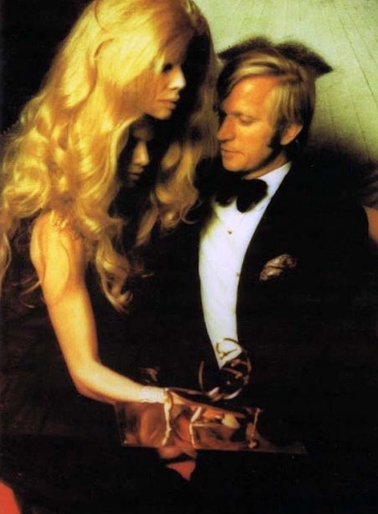 The Baroness Thyssen-Bornemizza & Guy Baguenault de Puchesse
The Baroness Thyssen-Bornemizza & Guy Baguenault de Puchesse
 Salvador Dalí and the Italian princess Maria Gabriella de Savoia
Salvador Dalí and the Italian princess Maria Gabriella de Savoia
 Charles de Croisset, Marisa Berenson snd Paul-Louis Weiller
Charles de Croisset, Marisa Berenson snd Paul-Louis Weiller
 Claude Lebon and Charlotte Aillaud
Claude Lebon and Charlotte Aillaud
 Hélène Rochas & François-Marie Banier
Hélène Rochas & François-Marie Banier
 For desert: a sugar made woman laying in a bed of roses
For desert: a sugar made woman laying in a bed of roses
by Jade Reason
La vía del estilo
Art still has truth. Take refuge there.
Tales from Tinseltown...recording them now...I'll let you know when it's story time.
My Work My Art My Show - new school Sex and the City
All my words that are fit to print (and other's too!)
Making Life more Beautiful
Tulio Silva
Life, Leisure, Luxury
MYTHS AND HISTORIES OF A RELUCTANT BLOGGER
All my aimless thoughts, ideas, and ramblings, all packed into one site!
Meaning in Being. You be you.
Poetry, musings and sightings from where the country changes
Cooking is personalization.
Creativity is within us all